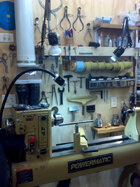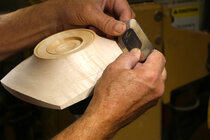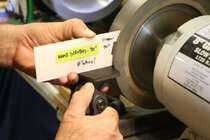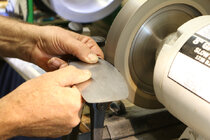I have opened a couple of other threads on finishing recently. I figure it won't hurt to start another. Something I've often run into, when I use a variety of finishes, are either witness marks (which I think is what occurs when you sand through, entirely or partially, a prior coat before layering on the next), or sanding scratches that are not visible on the bare wood, but show up once you start coating on layers of finish.
I used to run into witness marks a fair bit, when I spent several months trying to learn how to optimally apply poly, without much success. I eventually learned just how important wood surface prep was, and how perfect the surface needed to be, in order to get a good quality, shiny (to one degree or another) poly (or spar) finish. The amount of effort at the time seemed rather daunting, and I fell back on my more trusted approach: shellac with Acks sanding paste and polishing wax. It produces this nice satin sheen that I really love, although its not really durable.
Thing about the shellac...it very easily makes any and all remnant sanding scratches, if they are not otherwise perfectly obscured in the grain and other features of the wood, show right through! In fact some times it seems as though shellac can even greatly enhance them and make everything look quite terrible. The worst part of it is, I will often spend a heck of a lot of time prepping the wood surface, examining the piece from a wide variety of angles, to see if I've found and eliminated all the scratches, before putting on the first coat of shellac. The way bare wood fibers disperse and scatter light, I think, is what makes it so hard to see these scratches. I've gotten into, what I think is actually a bad habit, of sanding with rather fine grits...I used to stop at 320 or 400, but now I'm up to 600 and even 800 on most pieces, and sometimes even 1200, after which I'll maybe go back down to 800 once I'm sure I've removed all the scratches, as even shellac doesn't seem to penetrate the smooth, closed off pores from 1200 grid sanding.
I am wondering if I am missing something, here, about witness marks and visible scratches. Are there techniques to help ensure you either don't leave any scratches from lower grit sandpapers behind at all, or help you make sure you clean all of them up more easily, before you start layering on your finish? My eyesight, even though I'm only 45, is not the best...I have what my eye doc calls "cloudy masses" in my vitreous humor, which often sit right in the middle of my vision. They make my vision a bit milky, which then makes it hard to see fine details. I picked up a pair of glasses for close up vision, which has helped a bit, but if these cloudy masses get in the way, its often hard to move them out of the way and they do limit my vision. I don't know what to do here, really, to make sure I'm fully eliminating scratches in particular. I feel like I spend an inordinately exorbitant amount of time trying to produce a clean, scratch-free surface, that its ultimately not worth it (I mean, I sell most of my work, and while I don't pay myself an hourly wage, if I do account for it, I could never actually make any revenue, let alone a profit.)
I don't often run into the problem of sanding through a prior coat of finish that much anymore, however, I also haven't been using much poly and never used much lacquer until recently. So I don't know if it'll become a bigger problem in the future if I get back to using them.
There has been some discussion on how some of you apply your finishes. Danish oils in particular. Seems the process often involves wet sanding (I assume with the oil finish itself), rubbing/burnishing the finish into the wood, and maybe more wet sanding later on in the process, before final coats are layered on. Does this process of wet sanding help eliminate scratches and the like from prior sanding? Or are there other purposes for it as well? Some of the pieces I've been seeing that are finished with these longer, thoroughly burnished in, wet sanded processes, are truly amazing, with beautiful wood surfaces, that as far as I can tell bear no witness to any kind of defect at all. I have to say, that kind of finish, is truly appealing, and I'd say the pinnacle of a well finished piece. Right now for me, though, I feel its a "some day, if I can master the basics"...
I used to run into witness marks a fair bit, when I spent several months trying to learn how to optimally apply poly, without much success. I eventually learned just how important wood surface prep was, and how perfect the surface needed to be, in order to get a good quality, shiny (to one degree or another) poly (or spar) finish. The amount of effort at the time seemed rather daunting, and I fell back on my more trusted approach: shellac with Acks sanding paste and polishing wax. It produces this nice satin sheen that I really love, although its not really durable.
Thing about the shellac...it very easily makes any and all remnant sanding scratches, if they are not otherwise perfectly obscured in the grain and other features of the wood, show right through! In fact some times it seems as though shellac can even greatly enhance them and make everything look quite terrible. The worst part of it is, I will often spend a heck of a lot of time prepping the wood surface, examining the piece from a wide variety of angles, to see if I've found and eliminated all the scratches, before putting on the first coat of shellac. The way bare wood fibers disperse and scatter light, I think, is what makes it so hard to see these scratches. I've gotten into, what I think is actually a bad habit, of sanding with rather fine grits...I used to stop at 320 or 400, but now I'm up to 600 and even 800 on most pieces, and sometimes even 1200, after which I'll maybe go back down to 800 once I'm sure I've removed all the scratches, as even shellac doesn't seem to penetrate the smooth, closed off pores from 1200 grid sanding.
I am wondering if I am missing something, here, about witness marks and visible scratches. Are there techniques to help ensure you either don't leave any scratches from lower grit sandpapers behind at all, or help you make sure you clean all of them up more easily, before you start layering on your finish? My eyesight, even though I'm only 45, is not the best...I have what my eye doc calls "cloudy masses" in my vitreous humor, which often sit right in the middle of my vision. They make my vision a bit milky, which then makes it hard to see fine details. I picked up a pair of glasses for close up vision, which has helped a bit, but if these cloudy masses get in the way, its often hard to move them out of the way and they do limit my vision. I don't know what to do here, really, to make sure I'm fully eliminating scratches in particular. I feel like I spend an inordinately exorbitant amount of time trying to produce a clean, scratch-free surface, that its ultimately not worth it (I mean, I sell most of my work, and while I don't pay myself an hourly wage, if I do account for it, I could never actually make any revenue, let alone a profit.)
I don't often run into the problem of sanding through a prior coat of finish that much anymore, however, I also haven't been using much poly and never used much lacquer until recently. So I don't know if it'll become a bigger problem in the future if I get back to using them.
There has been some discussion on how some of you apply your finishes. Danish oils in particular. Seems the process often involves wet sanding (I assume with the oil finish itself), rubbing/burnishing the finish into the wood, and maybe more wet sanding later on in the process, before final coats are layered on. Does this process of wet sanding help eliminate scratches and the like from prior sanding? Or are there other purposes for it as well? Some of the pieces I've been seeing that are finished with these longer, thoroughly burnished in, wet sanded processes, are truly amazing, with beautiful wood surfaces, that as far as I can tell bear no witness to any kind of defect at all. I have to say, that kind of finish, is truly appealing, and I'd say the pinnacle of a well finished piece. Right now for me, though, I feel its a "some day, if I can master the basics"...











